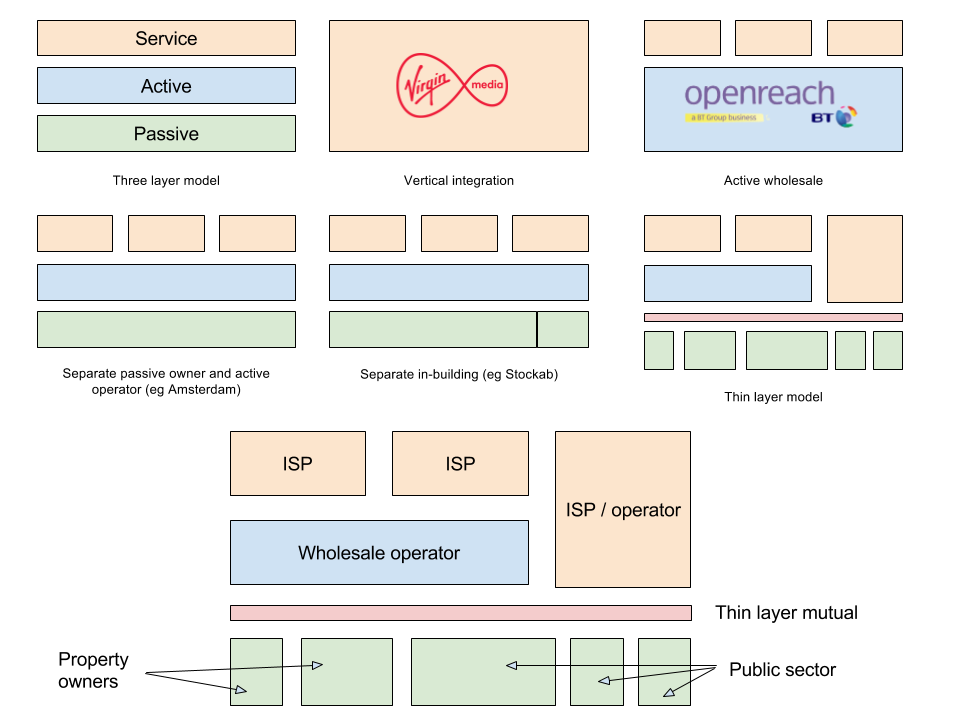Thin Layer Model
Rapid fibre deployment through public and private sector collaboration
Summary
The UK needs to accelerate deployment of full-fibre networks. While market disincentives are limiting investment, there’s untapped potential for the public sector to use its buying power to support the investment case. Using an innovative structure, the Thin Layer Model aggregates demand while desegregating the need for investment. This helps realise the benefit of public sector buying power by making smaller investments viable, and provides a framework for multiple investors to work alongside without ‘overbuild’.
The problem
A new approach is needed
The UK lags behind many other countries in the deployment of full fibre. A range of disincentives to investment slow progress in catching up. Widespread deployment in the UK of superfast hybrid copper networks weaken the immediate investment case for full fibre, leaving meagre pickings for investors: areas that are difficult to reach, that lack scale, or that are isolated from other viable areas.
The drive for public service transformation and the need for greater collaboration, for example on health and social care, provide an unprecedented opportunity to leverage public sector demand. But the demand aggregation solutions on offer generally require agreement from multiple partners before signing a long contract with a single supplier. This makes it harder to assemble demand. What’s more, these service-focused solutions offer only limited savings for the public sector as bandwidth demand rises.
The solution
The thin layer model helps resolve these issues
Public networks can be seen as having three ‘layers’: passive, active and service. These correspond to the physical assets (eg fibre), the electronic protocols that transport data (eg Ethernet), and the services that are offered to end users (eg broadband). A fully-integrated provider like Virgin Media owns and operates all three layers. A wholesale provider like Openreach owns and operates the bottom two (passive and active), with competing providers (ISPs) offering the services. Some networks (eg Amsterdam Citynet) have a separately owned passive layer with one or more active operators and multiple ISPs (see diagram). These are favoured by authorities such as the European Commission because they promote greater competition.
The thin layer model goes one step further and allows multiple owners of the passive layer. The infrastructure is presented by the ‘thin layer’ (see diagram) to operators as an integrated whole. The thin layer is mostly a contracting body, constituted as a mutual to guarantee neutrality. It charges operators access fees and pays asset owners rent. It also makes arrangements for fibre maintenance.
 The thin layer model allows an integrated infrastructure to be assembled piece by piece. This is analogous to the Internet itself, where multiple networks are sewn together into a larger ‘Inter-net’ with peering agreements. This flexible structure has been an important factor in its rapid growth.
The thin layer model allows an integrated infrastructure to be assembled piece by piece. This is analogous to the Internet itself, where multiple networks are sewn together into a larger ‘Inter-net’ with peering agreements. This flexible structure has been an important factor in its rapid growth.
The outcome
The thin layer model offers multiple advantages
The thin layer allows investors to deploy new duct and fibre, safe in the knowledge that it will form part of a larger whole. Instead of competing by ‘overbuilding’, multiple investors can share in the returns available across a wider area.
Property owners can install ducting, safe in the knowledge that this will enhance property value and without needing to worry about contracting with operators. Developers and local authorities can deploy ducting at low cost as they build, widen roads or deploy new transport infrastructure, safe in the knowledge that it can be brought into use later. This approach can be linked to a ‘Dig Once’ policy.
Public sector agencies can invest in infrastructure to meet specific new needs and save costs, without needing to sign a big outsourcing or anchor tenant deal. They can continue to outsource to PSN and systems integrators, while reaping the benefits of owning their own infrastructure. As owners of the physical assets thy can leave maintenance and complex network operations to providers with the competences required.
The thin layer retains the confidence of public sector agencies with differing priorities as well as competing operators because of its neutrality, which is guaranteed by its mutual status. This is analogous to the peering exchanges that mediate traffic between parts of the Internet.
The guaranteed neutrality underpins shared access to the infrastructure so that smaller and local digital businesses can tap in directly and capture more of the value chain, a stimulant for competition and innovation.
Tameside and CBN
Using the Thin Layer Model, Tameside MBC has built an alliance of public sector investors including NHS, education and housing bodies, and joined by private sector operator and service provider partners. Between them they have installed 12km of fibre duct with 23km under construction. They are using opportunities to install duct at low cost and commission new fibre services to save leased line fees.
CBN has worked closely with Tameside over the last 5 years on the conception, refinement and delivery of this model.
© Copyright CBN, 2017 http://broadband.coop



